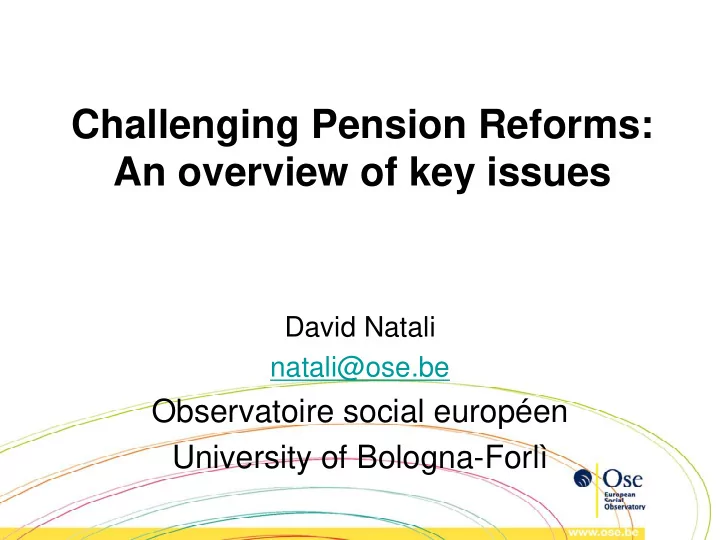

Challenging Pension Reforms: An overview of key issues David Natali natali@ose.be Observatoire social européen University of Bologna-Forlì
Challenges Pension Reforms (Critical reading of the Green Paper 2010) 1. Key tensions and challenges 2. Taking stock of 20 years of reforms 3. Potential solutions 4. Conclusion
1. Key Tensions and Challenges a) Ageing, old-age dependency ratio Commission, 2010
1. Key Tensions and Challenges a) Ageing Ervik, 2009
1. Key Tensions and Challenges a) Ageing, technological progress Ervik, 2009
1. Key Tensions and Challenges a) Ageing, employment progress (eco. dependency ratio) UN 2000
1. Key Tensions and Challenges b) Crisis and Private pension funds Pension funds’ nominal investment rate return in selected OECD countries (OECD 2009)
1. Key Tensions and Challenges b) PAYGO 1st pillar, automatic stabiliser Projected social spending bet. 2007 and 2010 (EPC, 2009)
1. Key Tensions and Challenges b) PAYGO 1st pillar, employment and growth • the fall of employment rates: 8 million jobs lost in 2009/10, after a growth of 9½ million in 2006/08 • potential growth rate in the euro-zone from 1.3%-1.6% (before the crisis) to 0.7%-0.8% (after the crisis) (EPC, 2009)
1. Key Tensions and Challenges d) Labour markets’ change • ‘Pension gap’ for a-typical workers and under-pensioned (fixed-term and part-time contracts, interrupted careers) • women, young, immigrants • more fragmented careers • insufficient contribution (low wages)
The Pension Gap, (pension income/average earnings for typical/a- typical workers and women, UK 2003) 50 40 10 4 30 Private Pension 4 State Pension 20 32 29 23 10 0 SER Male Non ‐ SER Women Source, PPI 2009
The Pension Gap, (pension income/average earnings for standard/non-standard careers, UK 2003) 45 41 39 38 40 31 35 30 27 30 Standard carrers 25 20 Non ‐ standard careers 15 10 5 0 2003 2028 2048 SER , 44 years (in full-time employment), at median earnings and retires at 65. Source, PPI 2009
1. Summing up… Green paper More critical reading a.Ageing and old age a.Ageing and economic dependency dependency b.Eco-financial crisis b.Eco-financial crisis and c.Reforms’ impact single schemes c.Reforms’ impact d.Mismatch bet. Labour markets and pension policy
2. Taking stock of 20 years of reforms , for the Green Paper • Increased risks of adequacy gap • Increased risks for pension funds (need for more efficient regulation) • Need to review the pension promises
2. Taking stock of 20 years of reforms, recasting pensions is not impossible Main reforms France Pension Reform 1993 Pension Reform 1995 Pension Reform 1997 Pension Reform 2001 Pension Reform 2003 Pension Reform (public sect or) 2008 Pension Reform 2010 Italy Pension Reform 1992 Pension Reform 1993 (supplement ary pensions) Pension Reform 1995 Pension Reform 1997 Pension Reform 2004 Welfare Prot ocol 2007 Pension Reform (public sect or) 2009 Poland Pension Reform 1991 Pension Reform 1997 Pension Reform 1998 Pension Reform 2002 Pension Reform 2004 Pension Reform 2008 UK Pensions Act 1995 Welfare Reform and Pensions Act 1999 Child S upport , Pensions and S ocial S ecurit y Act 2000 S t at e Pension Credit Act 2002 Pensions Act 2004 Pensions Act 2007 Pensions Act 2008 Natali, 2010
2. Taking stock of 20 years of reforms, effective cutbacks Gross replacement rates 2007/60 (EPC, 2009)
2. What distributional effects? Trends of net replacement rates through reforms (Zaidi, 2010)
2. What distributional effects? Trends of net replacement rates through reforms (Zaidi, 2010)
2. What distributional effects? Trends of net replacement rates through reforms (Zaidi, 2010)
2. Taking stock of 20 years of reforms, public/private management Privatization discourse • Insulation from political interference • Better quality of services • Greater operating efficiency • Freedom of choice • Excessive costs (marketing) • Need for effective regulation
2. Taking stock of 20 years of reforms, public/private management Swedish comparison of public and private pension funds (Premium Pensions), Cronkvist and Thaler 2004
2. Taking stock of 20 years of reforms, a more in-depth focus Green paper More critical reading •Increased risks of adequacy gaps •Recasting pensions is difficult but not impossible • Increased risks for pension funds • Reforms have been quite effective (need for more efficient regulation) (future benefits much lower) • Reforms can be implemented in • Need to review the pension promises many different ways (with varied distributional effects) •The role of private pension funds must be assessed (need for efficient regulation/governance)
3. Potential solutions Green Paper More critical reading 1. Ageing 1. Ageing I. Higher retirement age I. Higher Productivity (R&D, welfare) II. Higher employment rates II. Tax policy III. Importing labour/Exporting capital 2. Eco-financial crisis 2. Eco-financial crisis I. better governance/regulation of I. More effective regulation supplementary private funds II. More effective II. Need of economic -employment governance growth 3. Adequacy gaps 3. Adequacy gaps I. focus on distributional effects I. Higher basic pensions II. Flexible retirement age II. Higher riterement age
4. Conclusion 1. Key role of indicators and discourses I. Dependency ratio, Public/private mix 2. Need for an open approach I. Multi-policy perspective, evidence-based approach 3. Issue of distribution I. Across occupational, gender, age groups
Recommend
More recommend